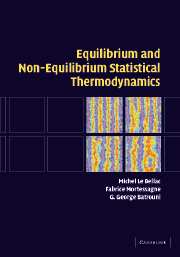Book contents
- Frontmatter
- Contents
- Preface
- 1 Thermostatics
- 2 Statistical entropy and Boltzmann distribution
- 3 Canonical and grand canonical ensembles: applications
- 4 Critical phenomena
- 5 Quantum statistics
- 6 Irreversible processes: macroscopic theory
- 7 Numerical simulations
- 8 Irreversible processes: kinetic theory
- 9 Topics in non-equilibrium statistical mechanics
- Appendix
- References
- Index
6 - Irreversible processes: macroscopic theory
Published online by Cambridge University Press: 03 December 2009
- Frontmatter
- Contents
- Preface
- 1 Thermostatics
- 2 Statistical entropy and Boltzmann distribution
- 3 Canonical and grand canonical ensembles: applications
- 4 Critical phenomena
- 5 Quantum statistics
- 6 Irreversible processes: macroscopic theory
- 7 Numerical simulations
- 8 Irreversible processes: kinetic theory
- 9 Topics in non-equilibrium statistical mechanics
- Appendix
- References
- Index
Summary
In the preceding chapters, we have limited our analysis to equilibrium situations. This is rather restrictive since non-equilibrium phenomena, such as heat conduction or diffusion, are of great interest and cannot be ignored. To remedy this, we focus in this chapter on an introduction to non-equilibrium phenomena. Further developments of the subject will be found in Chapters 8 and 9.
We have seen that equilibrium statistical mechanics is built on a general and systematic approach, namely the Boltzmann–Gibbs distribution. No such general approach is available for non-equilibrium situations; instead, we find a large variety of methods suited to particular cases and situations. What we are able to control well are cases close to equilibrium where we can rely on rather general methods like linear response theory, which will be described in Sections 9.1 and 9.2. In the present chapter, we shall consider a macroscopic approach, that of transport coefficients, which is the non-equilibrium analogue of equilibrium thermodynamics. At this stage, we shall not attempt a calculation of these transport coefficients from a microscopic theory. We shall only show that these coefficients satisfy a number of general properties, their actual values being taken from experiments. This parallels equilibrium thermodynamics where we uncovered a number of general relations between thermodynamic quantities while we did not attempt to calculate, for example, the specific heat from a microscopic theory but took its value from experiments.
- Type
- Chapter
- Information
- Equilibrium and Non-Equilibrium Statistical Thermodynamics , pp. 335 - 374Publisher: Cambridge University PressPrint publication year: 2004



